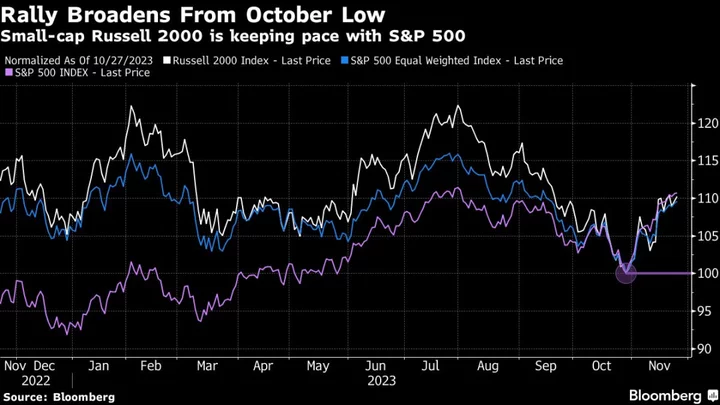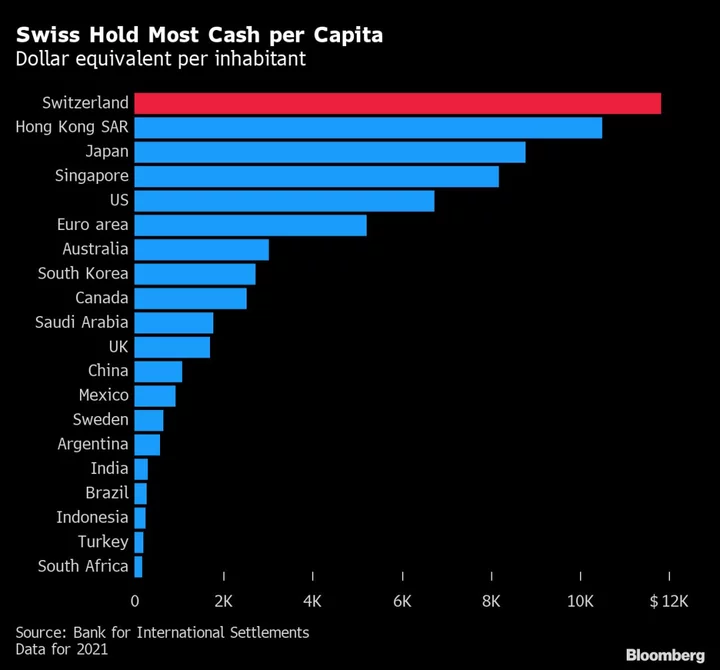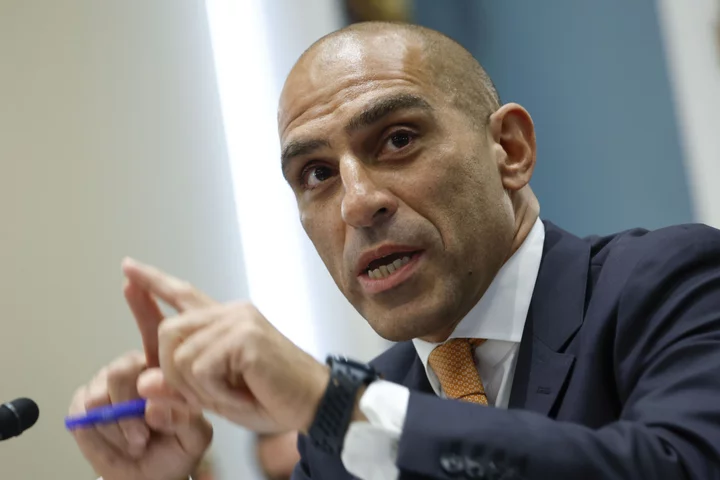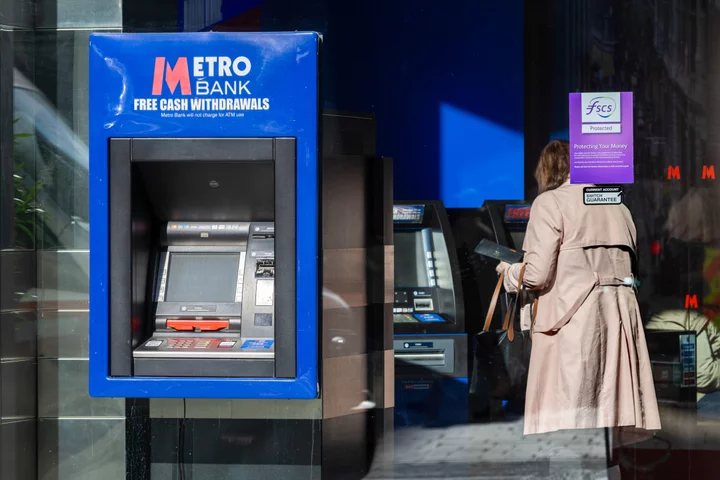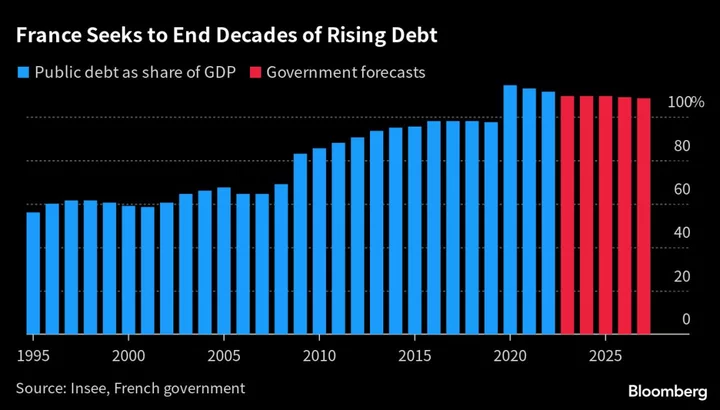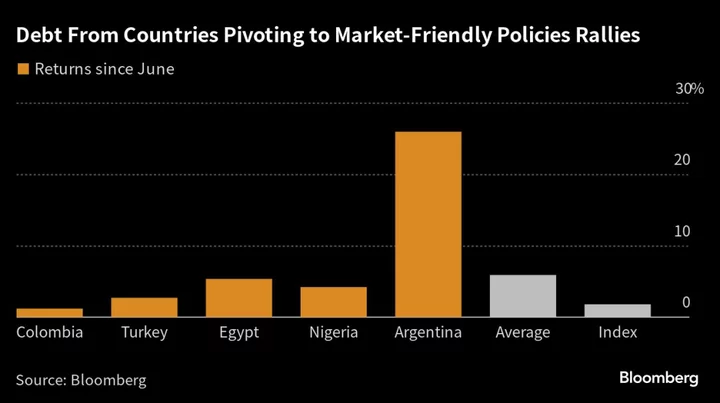It’s the major casualty of November’s sizzling stock rally: Investor caution.
Thanks to what’s shaping up to be one of the biggest market meltups over the last 100 years, demand for protective strategies has all but evaporated. Professional and retail traders are battling to keep pace with an S&P 500 that has advanced almost 9% this month alone. Erstwhile defensive refuges — everything from inflation-protected bonds to cash ETFs and bearish options — are being jettisoned. In their place: Surging appetite for junk bonds and small-cap equities.
Powering it all is belief that the Federal Reserve is done raising interest rates and will start cutting them in 2024 — speculation that has portfolios split 60/40 between shares and bonds on track for their best month since 2020.
Minutes published Tuesday reinforced unity among money policymakers in proceeding “carefully” when it comes to the interest-rate path as they seek to rein in inflation back down to their 2% target.
“The Fed’s willingness to pause here and look through the strong data is allowing soft landing optimism to take over,” said Priya Misra, portfolio manager at JPMorgan Asset Management. Yet “the lack of hedging reflects complacency on inflation and living on a prayer.”
The S&P 500 jumped 1% for its fourth straight weekly advance, a period that has featured just three down sessions in 19 trading days. The benchmark is on track for a November gain that surpasses all but five since 1928. The Russell 2000, which investors look to for cues on the health of the economy, also edged higher by 0.5% this week. The Bloomberg 60/40 index has gained almost 7% this month alone.
Global equity funds posted their biggest two-week inflow since February 2022, according to EPFR Global data. Stock exchange-traded funds have pulled in $43 billion so far in November and are headed for their second best month this year, according to data compiled by Bloomberg. Two ETFs tracking cash-like funds saw $1.1 billion of outflows this week and investors have pulled $700 million out of the iShares TIPS ETF over three weeks.
Hedging demand has fallen sharply with the cost to protect against a market selloff down by around 10%, or one-standard deviation, tumbling to the lowest ever in data starting in 2013. Demand for tail-risk hedges that pay out in an equity fall as precipitous as 30% has also dropped and is hovering around the lowest level since March.
“There has been absolutely no demand for hedging — the cost of protection using various metrics are all near lows looking out five years,” said Amy Wu Silverman, head of derivatives strategy at RBC Capital Markets. “Additionally, volatility continues to be suppressed in our market due to volatility selling strategies.”
Meanwhile, Wall Street firms are busy predicting more gains to come. Helped by positive sentiment and resilient valuations, Lori Calvasina at RBC Capital Markets forecasts the S&P 500 will jump to a record high next year, as does Bank of America Corp.’s Savita Subramanian. The latter is optimistic because firms, she said, will learn to adapt to the higher rate environment.
The enthusiasm has even prompted hedge funds to hold their most concentrated wagers on US equities in 22 years with most popular bets in megacap tech. Mutual funds also increased their exposure to the sector in the third quarter, according to Goldman Sachs Group Inc.
Of those that capitulated include a pool of rules-based money known as commodity trading advisers. After sitting on the sidelines in late October, CTAs bought more than $60 billion worth of global equities in the last two weeks, according to Nicolas Le Roux of US Group AG, who expects flows to continue though at a slower pace.
Not everyone is buying. Marija Veitmane, senior multi-asset strategist at State Street Global Markets, is still concerned about recession risks and inflationary pressures, particularly on the services side. Americans feel it too. US short-term inflation expectations climbed to a seven-month high while longer-run price views remained at levels not seen since 2011.
“Current economic data still does not justify the current aggressive policy normalization,” said Veitmane. “Thus, rates need to stay higher for longer, which will most likely push us into recession which means that earnings expectation are too high. So, no we are not backing this rally.”
To Peter Chatwell, head of global macro strategies trading at Mizuho International Plc., the fact that ratey cuts may be coming is no sustainable reason for elated market sentiment.
“If the Fed is cutting rates because of a recession, this is very unlikely to be supportive of stocks,” he said. “It seems that stocks are in a sweet spot which will require a major earnings increase to allow this level to be maintained.”
--With assistance from Elena Popina.

